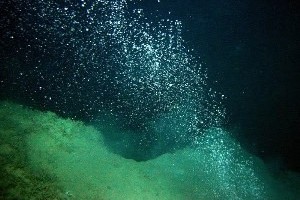Last week The Associated Press published an article claiming that bacteria ate all the Methane gas emitted by the BP Oil spill disaster in just four months.
This article was based on a scientific report produced by various authors one of the main being Professor David Valentine of The University of California.
Methane eating bacteria or Methanotrophs have long been known about and scientists have pondered the possibility of deploying them in such away to prevent a Methane driven runaway greenhouse effect as described on this web site.
Methanotrophs generally require a good source of oxygenated water before they can oxidize the Methane. The Gulf of Mexico doesn’t provide this environment as it is the second largest ocean dead zone on the planet for six months of the year. Being a dead zone simply means this area of ocean is starved of oxygen and becomes hypoxic.
The hypoxia starts at late spring, is at its’ highest in mid-summer, but oxygen levels return to normal in September. The Dead Zone is probably caused by fertilizers running into the Mississippi and St. Louis rivers which then run into the Gulf. These encourage algae blooms in the Gulf which cause the oxygen levels to become depleted.
The Deepwater Horizon sits in The Gulf of Mexico Dead Zone.
In Professor Valentine’s paper, they took readings of oxygen levels in an area around the rig during August when the hypoxia is at it’s highest and then made the assumption that these depleted levels didn’t extend further than the immediate area.
Quote from the paper: “We assume that no oxygen is depleted outside the selected area and depletions along boundaries are set to zero prior to contouring (Tables 1 and S1).”
They then made the assumption that the oxygen depletion was caused by the Methanotrophs oxidizing the Methane.
In doing this they used the terminology “We suggest that” as they were unable to make a statement of fact.
David Valentine is quoted as telling the Associated Press “The methane was completely consumed by early September… it happened very quickly and it was a surprise to us,”
David Valentine is right to be surprised.
In an extensive study of Methanotrophs by Hanson and Hanson MICROBIOLOGICAL REVIEWS, June 1996, p. 439–471 on page 452 it states the following:
In the open ocean, methane concentrations and rates of methane oxidation are low. In the Sargasso Sea, methane concentrations decreased only slightly in the top 500 m and microbial oxidation of methane was very slow compared with that in more productive waters. The turnover time for methane was 5 to 100 years. Very low rates of methane oxidation have also been observed for the Bering Sea and the Caribbean Sea (403).
Hanson’s study was conducted without the economic, environmental and political pressure of a BP Oil Spill.
In Summary:
The oxygen depletion or hypoxia found in August by David Valentine’s team is a feature of the annual reoccurrence of the Gulf of Mexico Dead Zone.
Methane is not oxidized by Methanotrophs quickly enough to remove a significant amount of Methane in such a short space of time.
It is more likely that the Methane sea water mix simply diffused and was carried away by the Gulf Stream into the North Atlantic.
David Valentine’s team noticed the oxygen levels in the water return to normal in September which again is a feature of The Gulf of Mexico Dead Zone.
In Conclusion:
Even if Methanotrophs had been able to oxidize all the Methane in the Gulf sea water, it makes no difference in a Methane driven runaway greenhouse effect. Sea water can absorb up to 5/6ths additional gas over thousands of years but in the case of a sudden emission this figure is greatly reduced and only a fraction of the gas is actually absorbed by the sea water.
In the videos of the capped well we ran on this web site, large amounts of Methane can clearly be seen reaching the surface.
Article by Redsky.


